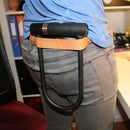Introduction: The Failed Attempt, Or: How Not to Replace Your Cookpot Handle With Sugru
First of all, this is my first project using Sugru. I wanted to make something with this amazing stuff for about half a year, but I just couldn't bring myself to order some. Two of the main reasons were that it is quite expensive and that it has an expiration date. So I had to think of some projects beforehand.
That said I'm now going to show you guys how I replaced the broken handle of our cast-iron pan. It broke about 2 months ago and my dad just put a screw and bolt on it to keep it useable. I thought it would just be a temporary fix but it just stayed on the lid - and nobody seemed to care. So I finally had a reason to order some Sugru ;)
Step 1: The Parts You Need
I thought quite a long time about how to replace the handle. Some different methods came to my mind, including a wooden ball covered in Sugru. But then I just took an old plastic cork of a wine bottle, a washer, a bolt and some Sugru.
Part list:
a plastic cork
a bolt
a washer
a nut
one minipack of Sugru
some masking tape (not pictured)
a lid with broken handle
some soapy water (if required)
Tools:
cordless power drill
pliers
allen key or screwdriver, depending on the bolt you use
Step 2: Drilling the Cork
The first step was to drill the cork with a fitting drill. I secured the cork with the pliers and drilled it lengthwise. Be careful! A step I would recommend before drilling is to shorten the cork a bit because one 5g pack of Sugru is nearly not enough to cover it completely.
After that came the fist fitting test. I put the screw through the hole in the lid and just stuck the cork on top. The bolt I used was a bit too long, so I just shortened it a bit with my dremel in the next step.
Step 3: Securing the Cork
The washer I used was to relief the stress put on the cork. After I thightend the screw I used my dremel to shorten it because it was a bit too long - I would recommend a fitting screw ;)
Step 4: Sugru!
But before the fun part comes: taping
I didn't know how the Sugru would react to the cast-iron and I didn't want to know either. So I decided to put some masking tape around the cork.
After that comes the fun part ;)
If you follow the instructions on the Sugru packet it is quite easy to work with. I just found it a bit difficult to get a nice and smooth surface but maybe that was just because I had relatively little material to work with. If you want to do this fix I would recommend to either shorten the cork or to use two minipacks.
Step 5: Molding the Sugru
After kneading the Sugru for half a minute I pressed it into a flat shape and began to mold it from top to bottom. There were several spots were the Sugru broke open and I found it quite hard to keep them shut. What helped me the most was some soapy water to keep my fingers damp.
Take your time and mold the Sugru nicely around the cork, because the mistakes you make while molding will stay forever ;)
Step 6: Finishing
It took me quite a while to close all the gaps and to smoothen the Sugru. I'm still not quite happy about the texture but I'm sure that it requires just some practise :)
When you're happy with the texture just let it sit for 24 hours. The Sugru will cure and be as resistant as it should be. After the Sugru is cured you can remove the masking tape and use your new handle ;)
Enjoy! :)
Step 7: Conclusion
I tried the handle for the first time today, with just some boiling water. The Sugru didn't have a problem with the heat at all, but the plastic cork underneath began to melt. There was molten plastic in the entire pot and even on the lid - nothing you want in your meal, do you?
So now I'm heading back to the drafting table and start from scratch, but I'm going to post my new 'ible if it works, promise!
So long!













